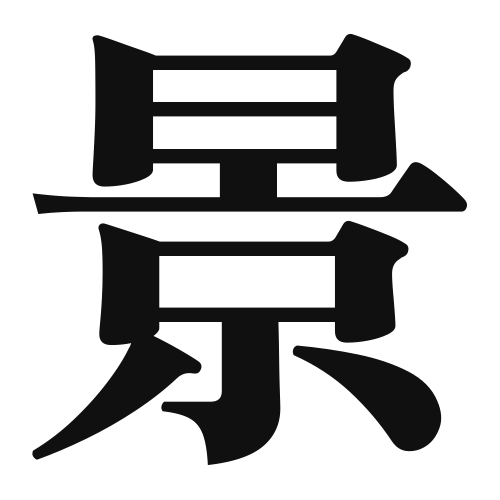1. Overview of Meaning
The kanji “景” (keik) primarily means “scenery” or “view.” It refers to the visual aspects of a landscape or environment, often evoking beauty and tranquility.
2. Formation and Radical
Formation of the Kanji: The kanji “景” is a compound character, which means it is formed by combining different elements. It is classified as a compound ideograph (会意文字), where the components convey a combined meaning. The left part represents “sun” or “light,” while the right part suggests “to reflect” or “to shine,” together symbolizing a beautiful view illuminated by light.
Radical: The radical of “景” is “景” itself, which is often associated with light and scenery.
3. Examples of Usage
Common Words and Phrases: Some frequently used words that include “景” are:
- 景色 (keshiki) – scenery
- 風景 (fūkei) – landscape
- 景観 (keikan) – view or landscape design
Example Sentences in Daily Conversation:
- この場所の景色は本当に美しいです。 (Kono basho no keshiki wa hontō ni utsukushii desu.) – The scenery in this place is truly beautiful.
- 山の風景を見ながらリラックスしました。 (Yama no fūkei o minagara rirakkusu shimashita.) – I relaxed while looking at the mountain landscape.
4. Synonyms and Antonyms
Similar Kanji: A similar kanji is “視” (shi), which means “to see” or “to view.” While “景” focuses on the visual beauty of a scene, “視” emphasizes the act of seeing or observing.
Opposite Kanji: An antonym could be “暗” (an), meaning “dark” or “gloomy.” While “景” suggests brightness and beauty, “暗” conveys a lack of light and can evoke feelings of sadness or fear.
5. Cultural and Historical Background
Relation to Japanese Culture: The concept of “景” is deeply embedded in Japanese culture, particularly in traditional arts such as painting and poetry, where nature and scenery are often celebrated.
Proverbs and Idioms: One common saying is “景色は心の鏡” (Keshiki wa kokoro no kagami), which translates to “The scenery is a mirror of the heart,” suggesting that one’s surroundings reflect their inner feelings.
